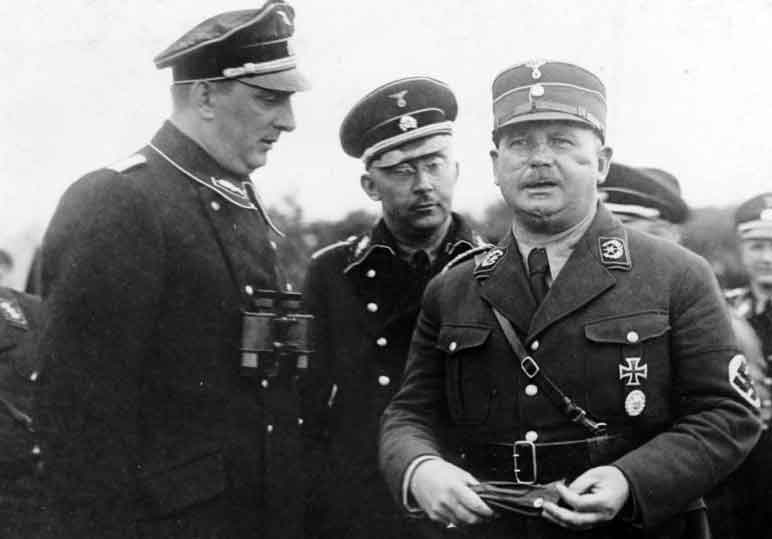Night of the Long Knives

Rohm with Himmlers
On the night of June 30th, Hitler eliminated embarrassing friends and foes alike. Seventy-seven people were executed, including SA leader Ernst Roehm, General Von Schleicher and his wife, former premier Gregor Strasser, a radical Nazi and Erich Klausenere, a prominent Catholic.
1934 was a year of Hitler's consolidation of power. Ironically the greatest threat to Nazi power in the first part of 1934 came from SA or the Storm Troopers, a key element in the Nazi's rise to power. The SA had grown exponentially after Hitler's rise to power, with its membership totaled 4.5 million, including 1.5 million members of the Steel Helmets who were incorporated into the SA. This number overwhelmed the 100,000 regular army troops that Germany was allowed to have under the Versailles agreement. Ernest Rohm, who headed the SA, began to develop an almost cult like following eerily similar to Hitler. He also called for the Brownshirts to become the army of Germany. The actions of the Brownshirts, which was destabilizing the country, resulted in calls for Hitler to take action against them by the military and conservative politicians. In addition, members of his close entourage, such as Goebbels, Goring, and Himmler, began urging him to take action- In April, Hitler reached an agreement with the military to curb the SA. In June, things came to a head when Vice-Chancellor Papen made a well-received speech simultaneously attacking the cult of personality that had developed while at the same time calling for an end of the calls for a second revolution. Papen threatened to resign, and despite the contempt Hitler felt toward Papen, he refused his offer to resign and promised to meet President Hindenburg to discuss the situation. When he met the ailing Hindenburg, the general threatened to declare martial law and put the army in charge of the country unless the SA was brought under control.
Hitler finally decided to act.
Night of the Long Knives
June 30th was the day that Hitler had decided to crush the SA. He decided to personally supervise the arrest of Rohm and the dismantling of the SA. Hitler flew to Munich, where the SA leader and his entourage stayed at a nearby resort of Bad Wiesse. He went to the Hanselbauer Hotel and personally arrested Rohm and many of his immediate entourage. Hitler accused them of plotting against him. Rohm was placed in a jail cell, and the next day despite being one of Hitler's first supporters, he was told to shoot himself. When Rohm refused, Hitler sent Theodo Eickle, the commander of Dachau, to execute him. How many were killed in the 24 hours between the 30th and July 1st is unknown, but the number runs into the hundreds. The Nazis used their crackdown on the SA as cover for attacking all potential critics of the regime- former German Chancellor General Kurt von Schleicher was assassinated, as was 73-year-old Gustav von Kahr, who had led the troops against Hitler Munich Beer Hall Putsch- Fritz Beck the director of the Munich Student Welfare fund was also killed. Gregor Strasser, one of the founders of the Nazi party, was killed, as were two of Papen's close aides, a clear warning to him not to stray from the party line. By the end of the day, it was clear there was only one leader in Germany, and that was Hitler.
 >
>